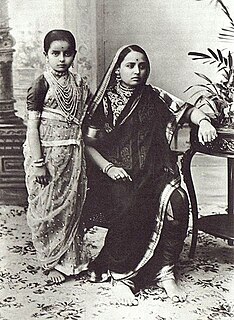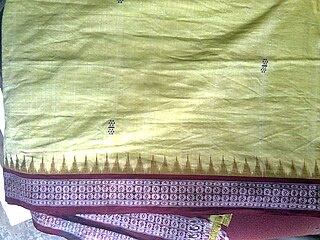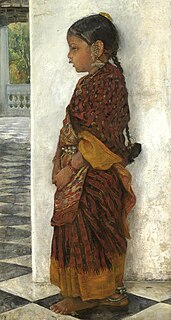Related Research Articles

A sari, saree or shari is a women's garment from the Indian subcontinent that consists of a drape varying from 4.5 to 8 meters in length and 60 to 120 centimetres in breadth that is typically wrapped around the waist, with one end draped over the shoulder, baring the midriff. There are various styles sari manufacture and draping, the most common being the Nivi style, which originated in the Deccan region. The sari is worn with a fitted bodice commonly called a choli and a petticoat called parkar or ul-pavadai. In the modern Indian subcontinent, the sari is considered a cultural icon.
Ikat is a dyeing technique used to pattern textiles that employs resist dyeing on the yarns prior to dyeing and weaving the fabric.

A Banarasi saree is a saree made in Varanasi, a city which is also called Benares or Banaras. The sarees are among the finest sarees in India and are known for their gold and silver brocade or zari, fine silk and opulent embroidery. The sarees are made of finely woven silk and are decorated with intricate design, and, because of these engravings, are relatively heavy.

Chinnalapatti is a municipal town in Tamil Nadu, India.

A Sambalpuri saree is a traditional handwoven ikat or sari wherein the warp and the weft are tie-dyed before weaving. It is produced in the Bargarh, Sonepur, Sambalpur, Balangir district, Boudh District of Odisha. The saree is a traditional female garment in the Indian Subcontinent consisting of a strip of unstitched cloth ranging from four to nine metres in length that is draped over the body in various styles.

Tussar silk is produced from larvae of several species of silkworms belonging to the moth genus Antheraea, including A. assamensis, A. mylitta, A. paphia, A. pernyi, A. roylei and A. yamamai. These silkworms live in the wild forests in trees belonging to Terminalia species and Shorea robusta as well as other food plants like jamun and oak found in South Asia, eating the leaves of the trees they live on. Tussar silk is valued for its rich texture and natural deep gold colour, and varieties are produced in many countries, including China, India, Japan, and Sri Lanka.
Bhagalpuri silk or Tussar silk is a dying style of silk sarees and other clothes from Bhagalpur, Bihar in India. This material is used for making sarees named as Bhagalpuri Sari. Bhagalpur is also known as “silk city” of India. Bhagalpur has numerous mulberry orchards to produce tussar silk. Nathnagar is a place where Bhagalpuri silk is mainly processed. Not only sari kurta suit is also made from Bhagalpuri silk.

Bomkai Sari is a handloom saree from Odisha, India. It is an origin of Bomkai, Ganjam district in the state and is primarily produced by the “Bhulia” community of Subarnapur district. Bomkai is one of the identified Geographical Indications of India. Sonepur handloom sarees, Sonepuri paatas and silk sarees are popular items displayed at various fashion shows.

Pasapali Sari is a handloom sari weaved mainly in the Bargarh district of Odisha, India. The name Pasapali is derived from pasā or gambling games using Chess board. These saris have intricate check patterns of contrast colors resembling the chess boards which gives it such name.
The handloom industry is one of the most ancient cottage industries in Salem district of Tamil Nadu, India. Sari, dhoti and angavasthram are made out of silk yarn and cotton yarn. In the recent past, home furnishing items are also woven, mainly for export purposes. More than 75,000 handlooms are working and the total value of cloth produced per annum is estimated at Rs.5,000 crores

Kanchipuram Silk is a type of silk saree made in the Kanchipuram region in Tamil Nadu, India. These sarees are worn as bridal & special occasion sarees by most women in Tamil Nadu, Karnataka & Andhra Pradesh. It has been recognized as a Geographical indication by the Government of India in 2005-06.
Baluchar Sari or Baluchuri Sari is a type of sari, a garment worn by women across India and Bangladesh. This particular type of sari originated in Bengal and is known for depictions of mythological scenes on the pallu of the sari. It was mainly produced in Murshidabad but presently Bishnupur and its surrounding places of West Bengal is the only place where authentic Baluchuri saris are produced. It takes approximately one week to produce one such sari. The Baluchari Sari has been granted the status of geographical indication in India.
Gadwal sari is a handcrafted woven sari style in Gadwal of Jogulamba Gadwal district in the Indian state of Telangana. It was registered as one of the geographical indication from Telangana by Geographical Indications of Goods Act, 1999. They are most notable for the Zari on the saris. The sari consists of cotton body with silk pallu which is also given a new name as Sico saris. The weave is so light that the saree can be packed in a matchbox. The Brahmostsavas of Tirupati begins with the Gods idol being adorned with gadwal Saree.

Chanderi sari is a traditional sari made in Chanderi, Madhya Pradesh, India.

Pochampally Saree or Pochampalli Ikat is a saree made in Bhoodan Pochampally, Yadadri Bhuvanagiri district, Telangana State, India. They have traditional geometric patterns in Ikat style of dyeing. The intricate geometric designs find their way into sarees and dress materials. The Indian government's official airplane company, Air India, has its cabin crew wear specially designed pochampally silk sarees.
Puttapaka Sari is a saree made in Puttapaka village, Samsthan Narayanpuram mandal in Nalgonda district, India. It is known for its unique Puttapaka tie and dye style of sarees.

Handloom sarees are a traditional textile art of Bangladesh and India. The production of handloom sarees are important for economic development in rural India. Completion of a single saree takes two to three days of work. Several regions have their own traditions of handloom sarees.
Kunja Bihari Meher was an Indian master craftsman and weaver from Odisha. Born in the Bargarh district, he is known for the Ikkat tradition of weaving, found in the Sambalpuri sarees of Odisha, and is credited with the development of Sambalpuri handloom industry. He was awarded the fourth highest civilian award of the Padma Shri by the Government of India, in 1998. He won the National Award for Handicrafts of the National Centre for Textile Design in 2009. His son, Surendra Meher, is also a known weaver.
Dharmavaram handloom pattu sarees and paavadas are textiles woven by hand with mulberry silk and zari. They are made in Dharmavaram of Anantapur district in the Indian state of Andhra Pradesh. It was registered as one of the geographical indication from Andhra Pradesh by Geographical Indications of Goods Act, 1999.
Kotpad Handloom is a vegetable-dyed fabric woven by the tribal weavers of the Mirgan community of Kotpad village in Koraput district, Odisha, India. Cotton sarees with solid border and Pata Anchal, duppatta with typical Buties / motifs, Scolrfs on cotton, silk, handloom stoles, and dress materials are all dyed with organic dyes. The natural dye is manufactured from the aul tree grown in this area. The Kotpad tussar silk saree with tribal art and Kotpad handloom fabrics with natural color is its specialty.
References
- ↑ Unnithan, Chitra (January 18, 2013). "IIM-A helps Bihar attract tourists". The Times of India .
- ↑ Subramani, A. (January 17, 2013). "Latest on GI list: Madurai malli, tequila". The Times of India . Retrieved 2018-07-07.